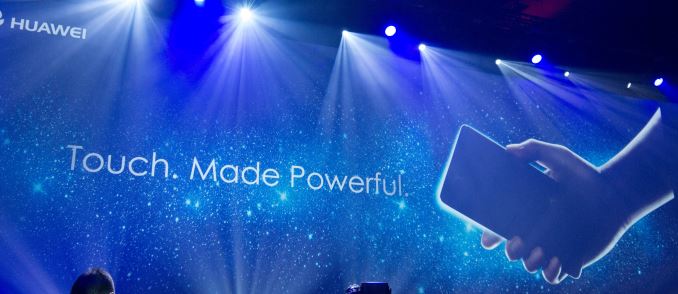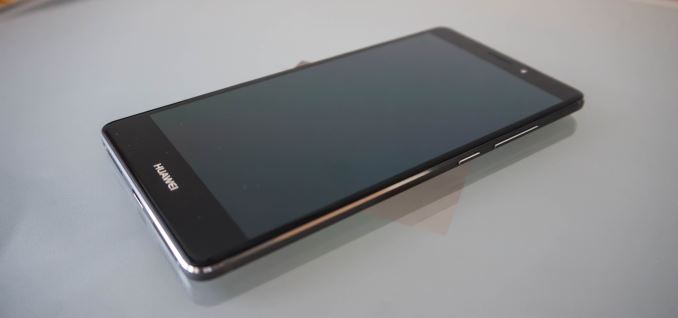Huawei Launches Mate S - Hands On
by Andrei Frumusanu on September 2, 2015 4:45 PM EST- Posted in
- Smartphones
- Huawei
- Mobile
- Trade Shows
- Mate S
- IFA 2015

Today at Huawei's IFA Berlin 2015 launch event the Chinese handset maker launched it's new fall flagship device, the Mate S.
The new 5.5" form-factor places the Mate S along-side other similarly sized devices such as LG's G4. This new form factor is a bit of a departure from previous designs for Huawei. The company has never offered a 5.5” phone before, their previous large format phone being the 6” Mate 7. This makes the Mate S more of a derivative of the Mate 7 than a successor, if not a new product category entirely.
Starting off, let's start with the spec sheet of the device:
| Huawei Mate S | ||
| SoC | HiSilicon Kirin 930 4x Cortex A53@1.5GHz, 4x Cortex A53e@2.2GHz Mali-T628MP4 |
|
| RAM | 3GB LPDDR3 | |
| NAND | 32GB/64GB NAND (128GB in 2016) + microSD | |
| Display | 5.5” 1080p SuperAMOLED Gorilla Glass 4 + Force Touch in 128GB model (2016) |
|
| Modem | 2G/3G/4G LTE Cat 6 (Integrated HiSilicon Balong Modem) |
|
| Networks | TDD LTE | B40 |
| FDD LTE | B1/B2/B3/B4/B5/B7/B8/B12/B17/ B18/B19/B20/B25/B26/B28 |
|
| UMTS | 850/900/AWS/1900/2100 (B19/B8/B6/B5/B4/B2/B1) |
|
| DC-42M | B1/B2/B4/B5/B8 | |
| GSM | 850/900/1800/1900 | |
| Dimensions | 149.8 x 75.3 x 7.2 mm, 156 grams |
|
| Camera | Rear Camera w/ OIS 13MP (4160 x 3120) Sony IMX278 Sensor F/2.0 aperture, 29mm eq. |
|
| Front Facing Camera 8MP Sony IMX179 F/2.4 aperture, 26mm eq. |
||
| Battery | 2700mAh(10.39 Whr) | |
| OS | Android 5.1.1 (64-bit) EmotionUI 3.1 |
|
| Connectivity | 802.11a/b/g/n 2.4GHz only BT 4.0, microUSB2.0, GPS/GNSS, DLNA, NFC |
|
| SIM Size | NanoSIM + NanoSIM (w/o microSD) |
|
The Mate S ships with HiSilicon's Kirin 935 SoC at the heart of the device. We have already taken a look at the Kirin in our review of the P8 a few months ago and found that the chipset exhibited some worrisome power consumption characteristics that lead to some reduced battery life. We had hoped HiSilicon would have been able to ship its next-generation SoC, the Kirin 950, in Huawei's fall flagship but I've been told that the chipset isn't ready till 2016 and likely will only find itself in Huawei's next spring lineup.
On the network side, we see that the Mate S supports a very wide range of frequency bands which should allow the western variant of the phone to function on most carrier networks. Still connectivity related, I was disappointed to see that Huawei yet again fell back to Broadcom's aging BCM4334 WiFi chipset. Also similar to the P8, the Mate 2 doesn't come with support for 5GHz WiFi, a very concerning characteristic for a device of this price.
On the camera side, the Mate 2 directly adopts the camera system from the P8. This means a Sony IMX278 13MP RGBW sensor with OIS and an IMX178 8MP front-facing shooter. The camera uses a high-performing external ISP for advanced image processing. A new addition is a soft LED torch on the front of the phone specifically design for selfies.
Design-wise the back of the Mate S looks extremely similar to the Mate 7; it would be hard to distinguish them straight-on if it weren't for their size difference. There is however one big change in the design of the phone: the back curvature. Together with the rounded bezels of the 2.5D screen, this results in the edges of the Mate S being extremely thin, far less than the 7.1mm maximum thickness at the centre of the device. Both of these design features make the Mate S one of the most comfortable devices I've used to date.
The Mate S also improves on previous Mate products in terms of build-quality. The aluminium of the full-metal body comes with a finer grain than what was found on the P8, yet still seems grippier than the Mate 7's finish. The new 2.5D glass front is also surrounded by a much higher-quality material, which I'm not sure if it's metal or a glass extension. The Mate 7 here featured a little plastic rim that could be easily chipped when dropped.
I was extremely surprised when I unpacked my unit as I came to the realization that the device comes with an AMOLED screen. This wasn't specified in the launch presentation and something that I overlooked in the bright lights of the demo unit stands. A quick dig through the device's drivers revealed that Huawei is using one of Samsung Display's higher-end DDICs. The screen also managed to get extremely bright, not unlike the Galaxy S6, so we might be looking at one of SDC's latest generation screens.
The 1080p screen is visibly using a diamond-grid pentile pixel matrix, although it's not noticeable until you get close to the screen. The Note 3 is probably the best comparison device here when it comes to the sharpness of the screen. Huawei's colour profile seemed a bit saturated in terms of colour calibration, but I won't be able to tell more until I get to measure it properly for the device's review.
A big feature that was touted during the launch was the reveal of "Force Touch" - a new input method where the screen is able to sense the amount of pressure one applies to touches. Huawei demonstrated a few features such as zooming via touch pressure or being able to use the bezels of the screen as input areas. The device even comes with a scale application that is supposed to be able to approximate an object's weight when you place it on the screen.
The catch however is that the Force Touch feature is limited to the 128GB model which according to Huawei won't be available until next year, and furthermore won't be released in all regions. It seems like the feature is not yet mass-production ready and Huawei is looking for suggestions and ideas on how the feature might could get used - meaning the software and functionality is still in the early stages.
The Mate S comes in Luxurious Gold, Titanium Grey (pictured) and Mystic Champagne colour options in 32GB and 64GB storage options for 649€ and 699€ respectively, and will be available in select markets in the coming weeks and months.















19 Comments
View All Comments
Ethos Evoss - Friday, September 4, 2015 - link
Ar you stupid ? force touch trademark of aplle ? Hahah you made me laugh..Since when (cr)apple manufacturers lcd screens? :-)
Mondozai - Wednesday, September 2, 2015 - link
So if you don't get forcetouch, you'll be paying 650 euros for a phone that is barely better than a Lenovo K3, which can be had for 150 via importing from China and then rooted(like I did)?Jeez, what a f*cking flop.
Lolimaster - Wednesday, September 2, 2015 - link
Or just get a Galaxy S5 which is the S6 done well.HardwareDufus - Thursday, September 3, 2015 - link
Permit me to add a little perspective for US Consumers. $649 Euros = $727 US Dollars. This for a 32Gb device. Is there any reason I can expect this device to perform better than any gently used 32GB SnapDragon 600/800 Device that I can purchase on Ebay for < $200 usd? Just adding perspective folks.nightbringer57 - Thursday, September 3, 2015 - link
"$649 Euros" looks a bit weird to me ;)By the way, don't forget that price conversions between EU and NA are usually 1$ <=> 1€.
Still, this thing looks way too expensive.
Ethos Evoss - Friday, September 4, 2015 - link
Don't worry the price will go down quicklyzodiacfml - Friday, September 4, 2015 - link
No but for the external looks only. I guess there are people attracted to the form as they keep producing similar designs and materials with higher prices. As you have said, most SoCs are not a significant upgrade from the 800 except those from the 14nm node which are significantly faster while uses less power.Pissedoffyouth - Tuesday, September 8, 2015 - link
Wonder if the power consumption is the crappy modem used. I know on my old mediatek phone the modem used a ton of battery.Anju78 - Thursday, August 23, 2018 - link
When i was scrolling your website https://clipboardwindows10.com/ then i get very useful information that is very crucial for me.